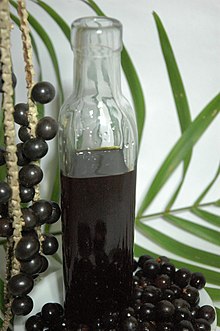This article needs additional citations for
verification. (March 2013) |
Açaí oil is obtained from the fruit of Euterpe oleracea ( açaí palm), which grows in the Amazon rainforest. The oil is rich in phenolic compounds similar in profile to the pulp itself, such as vanillic acid, syringic acid, p-hydroxybenzoic acid, protocatechuic acid and ferulic acid as well as (+)-catechin and numerous procyanidin oligomers. [1]
Açai oil is green in color and has a bland aroma. It is high in oleic and palmitic fatty acids (table). [2]

Uses
Açai oil is widely used for cooking and as a salad dressing. In cosmetics, it is used in shampoos, soaps and skin moisturizers. [2]
| Fatty acid | Percentage |
|---|---|
| Palmitic | 22.0% |
| Stearic | 2.0% |
| Arachidic | 2.5% |
| Palmitoleic | 2.0% |
| Oleic | 60.0% |
| Linoleic | 12.0% |
Source:[ citation needed]
See also
References
- ^ Pacheco-Palencia LA, Mertens-Talcott S, Talcott ST (Jun 2008). "Chemical composition, antioxidant properties, and thermal stability of a phytochemical enriched oil from Açaí (Euterpe oleracea Mart.)". J Agric Food Chem. 56 (12): 4631–6. doi: 10.1021/jf800161u. PMID 18522407.
- ^ a b Neida S, Elba S (2007). "[Characterization of the acai or manaca (Euterpe oleracea Mart.): a fruit of the Amazon]. [Article in Spanish]". Arch Latinoam Nutr. 57 (1): 94–8. PMID 17824205.